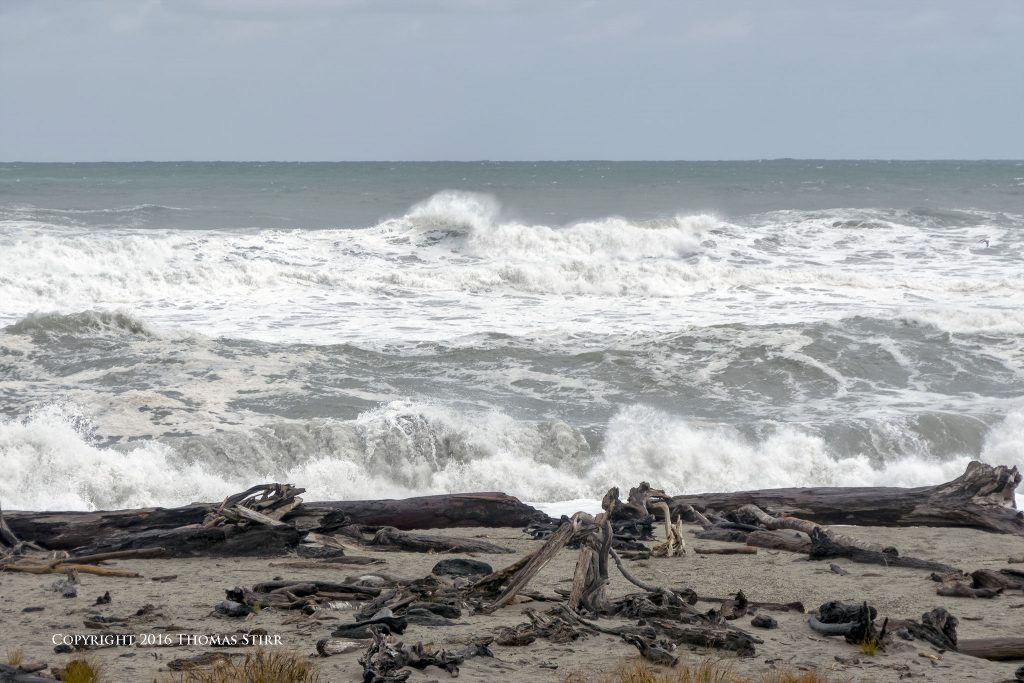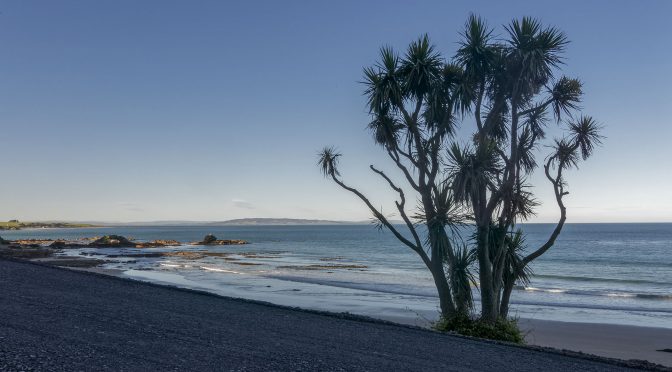Photography is, and always will be, subjective by nature. What one person finds inspirational, may leave another totally untouched. This article showcases some very simple compositions and discusses the power of simplicity.
NOTE: Click on images to enlarge.

My wife and I visited Great Sand Dunes National Park in Colorado last fall. While we were hiking out to climb on the sand dunes I was stopped dead in my tracks by the two people sitting on lawn chairs looking at the sand dunes. The awe that I was feeling looking at these incredible dunes was being demonstrated by them quietly sitting and taking in the visual wonder before their eyes. I wanted to include them in the image to create scale for the sand dunes, but also to capture the emotion created by their presence. Placing them in the corner of the photograph integrated them, but kept everything simple and balanced.

During a recent trip to New Zealand I got up a bit earlier in the morning and went out on the beach in Nelson. After taking some images of the beach and surf I spotted these bird footprints and a small piece of driftwood. This little scene reminded me that every day starts fresh and what happened yesterday is nothing more than a memory.

The image above is from that same morning in Nelson walking along the beach. I shot this photograph from a crouched position so I could get closer to the incoming waves and used a wide angle for the shot to give it added depth. I loved the feeling of distance, almost infinity, that the scene created in my mind.

The photograph above was taken on the dock in Glenorchy New Zealand. I purposely used a mid-length telephoto setting on my 10-100mm lens to compress the deck posts and bring the light post in towards the viewer. I also cut off the end of the dock on the left hand side to create a feeling of mystery as to where the dock leads. I loved the simple, repeating pattern created by the compressed dock posts. What also caught my eye was the monochromatic look of this scene which added to the simplicity.

In my mind the image above is all about the power of nature and a demonstration of cause and effect with the waves and driftwood on the beach. I loved the simple, raw power captured in the waves.

The photograph above is one that my wife captured during our visit to Wai-O-Tapu Thermal Wonderland on the North Island of New Zealand. I really like how she framed the bubbles in the thermal pool with some angled rock.
Sometimes simple swaths of colour in a scene can capture the eye and the imagination. This farm scene was taken en route to the town of Elora Ontario. I find the layered effect created by the bands of colour draw me into the image and help my eye exit to the top right behind the trees.

While this image above communicates a feeling of quiet solitude to me, it may not do that for other folks. There is always a risk with any photographic composition… as well as potential reward.

While driving back in the late afternoon from the lighthouse at Kaka Point on the South Island in New Zealand, the scene above grabbed me. I immediately pulled over to capture this image. I was drawn to the simple outline of the trees against the sky and the silhouette lighting. I left the gravel road in the foreground of the image to force the viewer’s eye towards the contrast of the trees and sky.
Allowing the power of simplicity to find its way into our photographs can open up new ways for us to see the world.
My intent is to keep this photography blog advertising free. If you enjoyed this article and/or my website and would like to make a modest $10 donation through PayPal to support my work it would be most appreciated. You can use the Donate button below. Larger donations can be made to tom@tomstirr.com through PayPal.
Article and most images are Copyright 2017 Thomas Stirr. Image also Copyright 2017 Rosemary Stirr. All rights reserved. No use, duplication or adaptation of any kind is allowed without written consent. If you see this article reproduced anywhere else it is an unauthorized and illegal use.


Hello Tom… I enjoy your posts and your easy-to-read writing style. I have learned a lot from your postings. In your Jan 21 response to Srikanth, you mentioned that you chose “a focus point about 1.7 metres (5.5 feet) in front of me. Since I was shooting at a focal length of 10mm I knew that everything from just under a metre away out to infinity would be in focus. “ Please help me understand as a beginner photographer – how did you “compute” that you needed to focus at 1.7 meters? Was this because you were using a 10mm lens? I am hoping to get sharper landscape shots. Thank you and looking forward to your reply!
Hi Gloria,
To answer your initial question, yes…I chose a spot about 1.7 meters away because I was using a 10mm lens (shot at f/5.6). I suspect that you would like more information than a simple ‘yes’ answer that so here’s a bit more to consider…
Every lens has its own optical properties, including the amount of depth-of-field that it will have at specific apertures, and at specific focal lengths (as in the case of zoom lenses). The wider angle the lens the more depth-of-field it will have. For example a 28mm lens will have more depth of field when shot at f/5.6 than will an 85mm lens shot at that same aperture, assuming that both lenses are focused on identical spots. The more you ‘stop down’ a lens, i.e. go from f/5.6 to f/8, the more depth-of-field will be created. When a lens is focused at the same spot it will have more depth-of-field when shot at f/8 than when it is shot at f/4.
In terms of knowing where to focus to achieve deep depth of field with a wide angle lens, much of this comes from experience and using various lenses and learning how they perform.
A quick way of getting some information is to do an online search for a ‘depth-of-field calculator’. You should be able to find a number of websites that have good depth-of-field calculators you can use. These allow you to enter the focal length of your lens, the sensor size of your camera, and the distance to a focusing point. The website will then automatically calculate the depth-of-field that will be generated by any given combination of factors. By playing around with these variables you’ll quickly see how depth-of-field changes based on the focal length of the lens, the camera sensor, the aperture used, and the distance to the focusing point.
When I first started using my Nikon 1 gear regularly for landscape images, rather than the full frame Nikon gear I used to own, I went online to one of these sites to check various depth-of-field calculations. I wanted to create a simple card that I could keep in my camera bag that would remind me how far away a focusing point would need to be to achieve ‘infinity’ focus when using a specific focal length lens at a specific aperture, when shooting landscape images. Since I typically shot my Nikon 1 gear at f/5.6 I checked how far away a focusing point would need to be to achieve ‘infinity focus’ at f/5.6, when shot at specific focal lengths, and what the nearest point in focus would be from the camera. I then used this card for quick reference. After a while it became second nature.
I know this likely sounds a bit complicated, but if you go online and find one of these depth-of-field calculators and play with it for a while I think things will become clear quite quickly.
Hope this has helped….
Tom
Thank you for your detailed reply, Tom. I’ll certainly give this a try.
Awesome photos as usual. Nicely shot.those waves are shot beautifully conveying a sense of infinity and calm. I am unable to nail focus on landscape and shots as this. Any tips please. And beautiful photos that you have shot. Keep the work flowing.
Srikanth
Hi Srikanth,
Thank you for your positive comment – much appreciated!
Typically with landscape/seascape images a photographer wants as much depth-of-field as possible. One of the important factors when shooting landscape/seascape images is to get to know how your gear performs, most importantly the depth-of-field characteristics of your lenses at various focal lengths. A simple thing to keep in mind is that the wider the focal length used, the more depth of field you will have at any given aperture. The image to which you referred in your comment was shot with a focal length of 10mm at an aperture of f/5.6. I chose a focus point about 1.7 metres (5.5 feet) in front of me. Since I was shooting at a focal length of 10mm I knew that everything from just under a metre away out to infinity would be in focus. I was able to use ISO-160 since the lighting available at the time gave me a shutter speed of 1/640. This was fast enough to ‘freeze’ the incoming waves which were slowly washing up on shore. So, it was the focal length of 10mm that was key in achieving the look of that particular image in terms of depth of field. It was the shutter speed that kept the waves looking sharp.
Let’s say I was still shooting with a D800 which is a full frame camera. I used to own the Nikkon 28mm f/1.8 so that lens would have given me almost the identical field-of-view as was used in my Nikon 1 image. The depth of field properties of a 28mm lens are quite different from that of a 10mm lens. If I would have captured that same image with full frame gear, focusing out at the same spot 1.7 metres away at f/5.6, that 28mm lens would have given me a total depth-of-field of less than 2 metres or so. To get the same depth of field as the image in the article I would have needed to stop the 28mm lens down to f/16, or composed the image differently by choosing a focusing point further away from me.
Shooting at f/16 with the D800/28mm lens combination would have affected shutter speed, reducing it by about 3 stops. This would have resulted in a shutter speed of about 1/80 which would have been too slow to ‘freeze’ the waves in the image and they would have looked blurred. To compensate for this I would have likely adjusted my ISO in order to use a faster shutter speed. Many photographers who use larger sensor cameras use apps on their phones to help calculate depth of field so they can decide on their focusing point in an image, aperture, and lens focal length.
Hope this has helped…
Tom
Very nice and informative reply. Thanks. Will try.
Simple can be wonderful. My favorite photos are 3 and 10.
I also enjoy taking photos of animal tracks that I find on my walks.
Thanks Joni – I’m glad you enjoyed the images! I will have to look for more tracks…
Tom